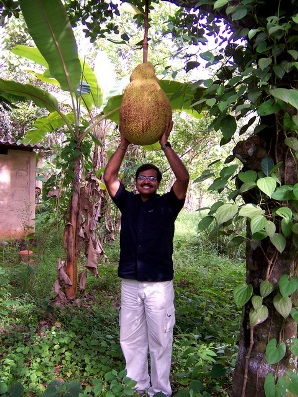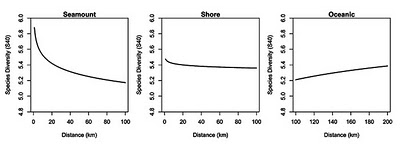Foot in the Jackfruit - a guest post from Kristie Cobb-Hacke
 Sunday, January 23, 2011 at 2:38PM
Sunday, January 23, 2011 at 2:38PM Where in the world are you when the expression “foot in the jackfruit” makes sense? Brazil. Recognizing that this euphemism “Pé na Jaca” loses some of its finesse in English, it is nevertheless something that makes travel beautiful.
 My goal during this adventure is to avoid “Pé na jaca.” Yesterday in our travels from Vitorio to Nova Viçosa throughout the drive we were able to see coffee plantations, sugar cane and eucalyptus farms. All of these farms were on formerly-forested areas, so interspersed we were able to spot the pink mangos, purple mangos and many other varieties of native plants. Although the jack fruit thrives in this environment, it is an invasive species. It is originally from India and archeologists have revealed it was first cultivated there 3,000 years ago. This tree has the largest tree-borne fruit and has spread quickly throughout areas of Brazil as birds and animals eat the seeds of fallen fruit and deposit them elsewhere. In recent years there have been some forestry management efforts to rid the national parks of saplings as these fruit are thought to have contributed to the decline of certain bird species.
My goal during this adventure is to avoid “Pé na jaca.” Yesterday in our travels from Vitorio to Nova Viçosa throughout the drive we were able to see coffee plantations, sugar cane and eucalyptus farms. All of these farms were on formerly-forested areas, so interspersed we were able to spot the pink mangos, purple mangos and many other varieties of native plants. Although the jack fruit thrives in this environment, it is an invasive species. It is originally from India and archeologists have revealed it was first cultivated there 3,000 years ago. This tree has the largest tree-borne fruit and has spread quickly throughout areas of Brazil as birds and animals eat the seeds of fallen fruit and deposit them elsewhere. In recent years there have been some forestry management efforts to rid the national parks of saplings as these fruit are thought to have contributed to the decline of certain bird species.
During our drive we discussed the cultural challenges that come with conservation efforts. The mere idea of discussing the lack of conservation in an area may be a time where I could certainly have been through of as insensitive. I certainly don’t want to be considered as an invasive species to the crew and scientists on the Abrolhos expedition. We discussed the change in the landscape and the growth in the farming industry, particularly eucalyptus.


This area of the world is considered a biodiversity hot spot by conservation international. This is an overview:
The Atlantic Forest or Mata Atlântica stretches along Brazil’s Atlantic coast, from the northern state of Rio Grande do Norte south to Rio Grande do Sul. It extends inland to eastern Paraguay and the province of Misiones in northeastern Argentina, and narrowly along the coast into Uruguay. Also included in this hotspot is the offshore archipelago of Fernando de Noronha and several other islands off the Brazilian coast.
Long isolated from other major rainforest blocks in South America, the Atlantic Forest has an extremely diverse and unique mix of vegetation and forest types. The two main ecoregions in the hotspot are the coastal Atlantic forest, the narrow strip of about 50-100 kilometers along the coast which covers about 20 percent of the region. The second main ecoregion, the interior Atlantic Forest, stretches across the foothills of the Serra do Mar into southern Brazil, Paraguay and Argentina. These forests extend as far as 500-600 kilometers inland and range as high as 2,000 meters above sea level. Altitude determines at least three vegetation types in the Atlantic Forest: the lowland forest of the coastal plain, montane forests, and the high-altitude grassland or campo rupestre. (www.biodiversityhotspot.org).
But in a place like Brazil that is growing and actively developing their resources, it is important to understand the ranking of conservation among the needs and challenges of a country that is home to approximately 3% of the world’s population: over 190 million people (http://en.wikipedia.org/wiki/Brazil) the vast majority living in urban cities. In many cases large numbers of citizens face much less complicated but much more personally critical decisions like food, clothing, water, waste management and health come long before thoughts of the care of the surrounding environment.
So for our bright and inspired scientists on this expedition it is going to be critical for them to be clear with their efforts and decisive with their results so that they can avoid sticking their ‘foot in the jack fruit” and they can begin the process of educating their fellow Brazilians and affecting change to preserve their native and incredibly diverse environment. On its own nature can maintain a diverse and complex system of life including production, consumption and disposal of waste. These processes are all seamless in a well-balanced system. If at any point a part of the system is disrupted the natural web may become imbalanced and threaten the health and loss of species at a minimum and, at a maximum, could be catastrophic.
Unfortunately, sometimes it takes catastrophe to serve as a wake-up call. One of our travel companions, Nina Bilton, is from the state of Rio de Janeiro and she shared that the recent torrential rains and the subsequent mud-slides have drawn tremendous attention to the environment and have activated the concern of a nation. So in all of this devastation one bright light is that dedicated committed scientists, organizations and corporations can occasionally come together to start the process of understanding the environment. At the core awareness is the science behind understanding the natural environment around us all.
As I write I am witnessing, for the first time, a completion of a submersible dive. I am excited to hear about what our researchers are seeing and learning and I’m looking forward to seeing the results. The data they have collected today is just one small piece to understand and protect the integrated web of life in the Abrolhos area.
(Kristie Cobb-Hacke is a vice president at Georgia Aquarium)



